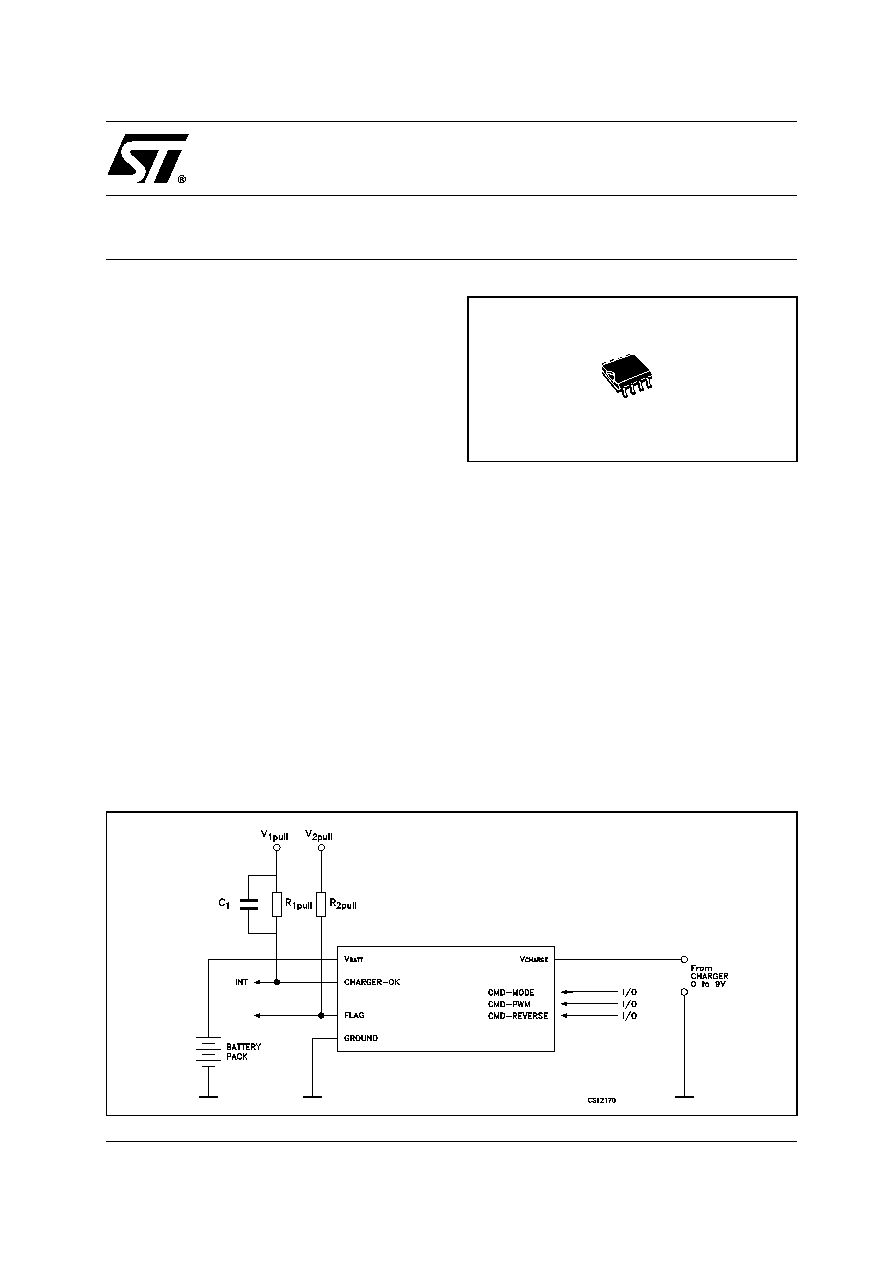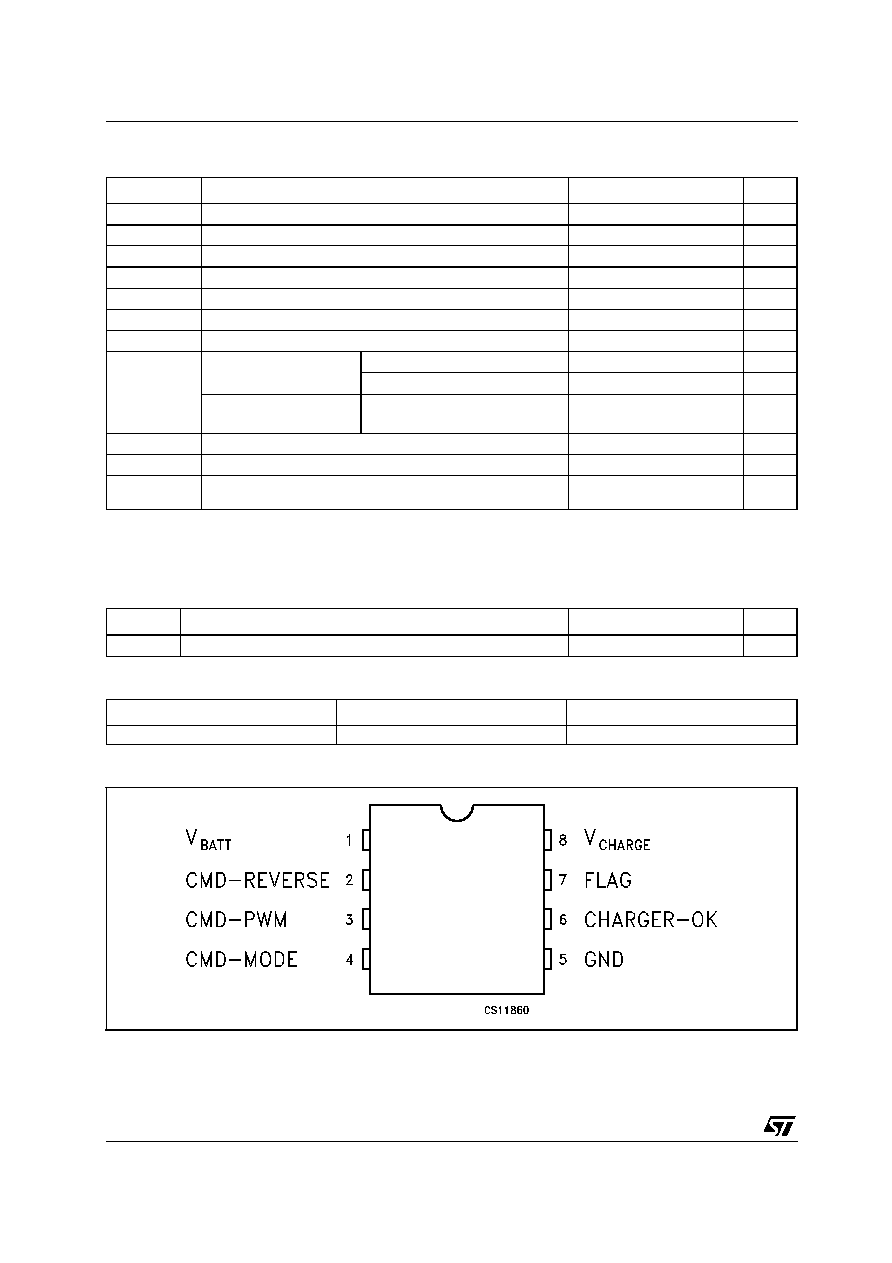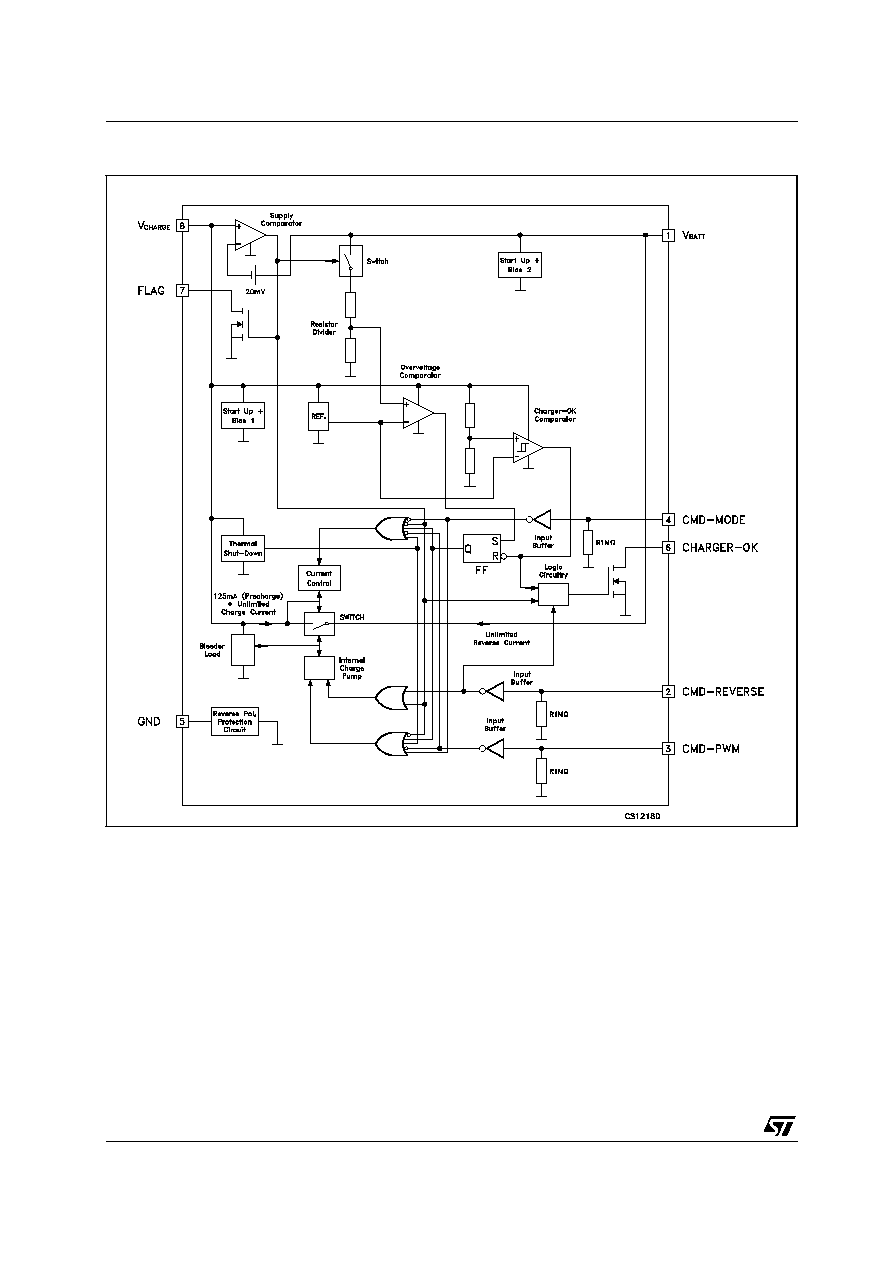
1/17
September 2003
s
DEDICATED I.C. FOR 1 LI-ION CELL OR 3
NI-MH CELLS
s
5 DIFFERENT OPERATING MODES
s
150 mA PRECHARGE CURRENT
s
VERY LOW DROP CHARGE SWITCH
(130mV @ 800mA)
s
VERY LOW DROP REVERSE SWITCH
(130mV @ 800mA)
s
5.7V OVER BATTERY OVER VOLTAGE
PROTECTION
s
CHARGER DETECTION MODE
s
(V
CHARGE
-V
BATT
) DETECTION MODE
DESCRIPTION
This specification describes a dedicated I.C.
which allows to charge 1 Lilon cell or 3 Nimh cells.
The principle used to charge the batteries is the
pulsed current, the monitoring is operated by the
micro-controller
of
the
application.
This
IC
integrates one Power Switch and achieves the
charge batteries in two different modes charge or
precharge.
One of this operating mode (charge or precharge)
can be selected in a static or pulsed way by one I/
O from a micro-controller. The IC can supply
power to accessories controlled by this I.C. in
Reverse mode. The I.C. is available in the smaller
and surface mounted SO-8 (exposed pad version)
package.
ST3S01PHD
BATTERY CHARGE I.C.
SCHEMATIC DIAGRAM
SO-8
exposed pad

ST3S01PHD
2/17
ABSOLUTE MAXIMUM RATINGS
Absolute Maximum Ratings are those values beyond which damage to the device may occur. Functional operation under these condition is
not implied.
(*) The I.C. is automatically turned OFF when V
CHARGE
reaches typically 14V (V
CHARGE
rising edge); typical hysteresis is 700mV (V
CHARGE
falling edge)
THERMAL DATA
ORDERING CODES
CONNECTION DIAGRAM (top view)
Symbol
Parameter
Value
Unit
V
BATT
Battery Voltage
-0.3 to 6
V
V
CHARGE
Charge Voltage (*)
-12 to 16
V
V
FLAG
(V
CHARGE
- V
BATT
) Flag Control Voltage
-0.3 to 12
V
V
CHARGER-OK
Charger Flag Control Voltage
-0.3 to 12
V
V
CMD-PWM
PWM Command Voltage
-0.3 to 5
V
V
CMD-MODE
CMD Command Voltage
-0.3 to 5
V
V
CMD-REVERSE
Reverse Command Voltage
-0.3 to 5
V
I
SWITCH
Internal Switch
Continuous Max Current
T
AMB
= 85°C, R
thj-amb
= 40°C/W
2
A
T
AMB
= 30°C, R
thj-amb
= 40°C/W
3
A
Internal Switch Peak
Current
T<1ms
Duty Cycle < 1%
R
thj-amb
= 40°C/W
8
A
T
stg
Storage Temperature Range
-55 to +125
°C
T
J
Operating Junction Temperature Range
-40 to +125
°C
T
AMB
Operating Ambient Temperature Range (if an adequate
heatsink is provided)
-40 to +85
°C
Symbol
Parameter
SO-8
Unit
R
thj-case
Thermal Resistance Junction-case
10
°C/W
TYPE
SO-8 exposed pad
SO-8 exposed pad (T&R)
ST3S01PHD
ST3S01PHD
ST3S01PHD-TR

ST3S01PHD
3/17
PIN DESCRIPTION
OPERATING MODE
Pin N°
Symbol
Name and Function
1
V
BATT
BATTERY pin: input pin when reverse mode is selected; output pin when in
charge or precharge mode
2
CMD-REVERSE Reverse Command pin: Enables the reverse mode when connected to a positive
voltage higher than 1.2V. Logic pin internally pulled down.
3
CMD-PWM
PWM Command pin: allows to control the precharge or charge switch in PWM
mode (refer to the Table 1 for the different operating modes). Logic pin internally
pulled down.
4
CMD-MODE
Mode Command pin: allows to switch between precharge and charge mode (refer
to OPERATING MODES Table). Logic pin internally pulled down.
5
GND
GND Pin
6
CHARGER-OK
CHARGER-OK output pin; open drain N-channel MOSFET that is in high
impedance when the V
CHARGE
voltage drops below 2.5V and CMD-REVERSE is
low. When the reverse function is activated, this open drain have the same
information of the (V
CHARGE
-V
BATT
) FLAG.
7
FLAG
FLAG pin (V
CHARGE
-V
BATT
): open drain N-channel MOSFET that sinks current
when the V
CHARGE
voltage is higher than the V
BATT
.
8
V
CHARGE
CHARGER SUPPLY pin: input pin when charge or precharge mode is selected;
output pin when in reverse mode.
CMD-PWM
CMD-MODE
Operating Function Selected
0
0
PRECHARGE MODE (Default state)
0
1
CHARGE MODE
1
0
CHARGE and PRECHARGE switches are open
1
1
CHARGE and PRECHARGE switches are open

ST3S01PHD
4/17
I.C. BLOCK DIAGRAM
POSSIBLE OPERATING MODES
Five different operating modes are allowed:
charge, precharge, reverse, charge+reverse and
precharge+reverse. These operating modes can
be
achieved
by
properly
selection
of
the
CMD-REVERSE CMD-PWM and CMD-MODE
(See POSSIBLE OPERATING MODE Table).
PRECHARGE MODE
The PRECHARGE function is composed by a
switch and a 100mA current source which fully
works for V
CHARGE
higher than 2.5V. When the
CMD-MODE and the CMD-PWM are not leaded
the switch is ON, being the input states held by an
internal pull down resistor. This is used when the
battery is strongly discharged. In this case V
BATT
can be null (battery empty) and all the input pins
are
not
held
by
any
level
(because
the
micro-controller is down), except the V
CHARGE
pin
which is a main supply. The source of current
supplies a constant current into the battery till its
voltage level reaches the required level allowing to
start the micro-controller (typically 3V). The
current direction is from V
CHARGE
to V
BATT
. The
reverse leakage current when the switch is ON
must be null; this is obtained thanks to an internal
circuitry that switch OFF the internal P-MOS when
the V
BATT
is higher than V
CHARGE
, whatever the
status of the CMD-MODE. The precharge function
is also used to adjust the mean current. When the

ST3S01PHD
5/17
battery is fully charged the current into the battery
has not to be more than C/25 (Nimh battery). In
order to perform finely this, the CMD-PWM pin
must be driven with PWM function (in the same
time, the CMD-MODE must be kept low). The duty
cycle allows to adjust the mean current needed.
CHARGE MODE
The CMD-MODE pin, when high (and CMD-PWM
low), handles the switch in charge mode. This
switch allows the battery charge with a strong
current. The drop of this internal P-Channel MOS
is very low (200mV @ 800mA) in order to optimize
the efficiency of the charge.
The switch is not internally protected against short
circuit or overcurrent condition.
When the switch is ON (CMD-MODE high and
CMD-PWM low), the current direction into the chip
is from V
CHARGE
to V
BATT
. The reverse current
when the switch is ON must be null; this is
obtained by mean of an internal circuitry that
switch OFF the internal P-MOS when the V
BATT
is
higher than V
CHARGE
, whatever the status of the
CMD-MODE. When the CMD-MODE pin is low or
in high impedance the switch is OFF, while it is ON
when the signal on that pin is high.
REVERSE MODE
When
the
reverse
function
is
selected
by
CDM-REVERSE pin, the switch allows to supply
the accessories with a strong current. The drop of
the internal P-Channel MOS is very low (200mV
@ 800mA) and the switch properly work for V
BATT
higher than 2.5V. This allows to supply energy on
the V
CHARGE
pin. When the switch is ON
(CMD-REVERSE high) the current direction into
the chip is from V
BATT
to V
CHARGE
.
The reverse current (from V
CHARGE
to V
BATT
)
when the switch is ON must be null; this is
obtained by mean of an internal circuitry that
switch
OFF
the
internal P-MOS when
the
V
CHARGE
is higher than V
BATT
, whatever the
status of the CMD-REVERSE. When the level of
CMD-REVERSE pin is low or in high impedance,
the switch is OFF, while it is ON when the signal
on CMD-REVERSE pin is high.
OVERVOLTAGE PROTECTION
This function allows to held the switches OFF
when the voltage level on V
BATT
is higher than a
maximum voltage whatever are the values of
CMD-PWM, CMD-MODE and CMD-REVERSE.
This maximum voltage is shown in the electrical
characteristic (typical threshold 5.7V). From the
moment in which the o.v.protection is activated, it
will be possible to turn ON again the switch only
when the V
CHARGE
value decreases down to 2.5V
typically, it doesn't matter which operation mode is
selected. The protection works only when the
battery is in charge or precharge mode, i.e.
V
CHARGE
> V
BATT
.
This represents, in fact, the typical application
condition where the battery could increase its
value, i.e. When charge or precharge mode are
used.
CHARGER DETECTION MODE
This function allows to generate a digital signal
(CHARGER-OK) to indicate if the V
CHARGE
voltage is higher than 2.5V and the reverse
function is inactive. This functionality allows to
determine if the charger is present or not; if the
V
CHARGE
is
lower
than
the
2.5V,
the
CHARGER-OK goes into high impedance (open
drain). When the reverse function is active, this
open drain have the V
CHARGE
-V
BATT
information.
This circuitry is directly supplied from V
CHARGE
pin
and works only for V
CHARGE
higher than 2.2V.
V
CHARGE
-V
BATT
DETECTION MODE
This function allows to generate a digital signal
(V
CHARGE
-V
BATT
) flag to indicate if the V
CHARGE
voltage is higher than V
BATT
; if the V
CHARGE
is
lower than the V
BATT
, this open drain goes into
high impedance state. This circuitry is directly
supplied from V
CHARGE
pin and works only for
V
CHARGE
higher than 2.2V.
THERMAL PROTECTION
An internal thermal shutdown circuitry will switch
OFF the P_MOS, only in precharge or in charge
mode, when the junction temperature reaches
typically 180°C. This has been implemented in
order to protect the device from overburning. 20°C
of
thermal
hysteresis
will
avoid
a
thermal
oscillation.
This circuitry is supplied from V
CHARGE
and, so,
acts only on the precharge and charge switches.
ESD PROTECTION
Both V
CHARGE
and V
BATT
pins are protected
against electrostatic discharge up to ±4KV (HBM,
MIL STD 833D.
CHARGE VOLTAGE
V
CHARGE
functional operating range is from 2.5V
to 12V. At V
CHARGE
=14V typically the I.C. is
automatically turned OFF and remains OFF up to
16V. A V
CHARGE
voltage higher than 16V can
damage the IC.




